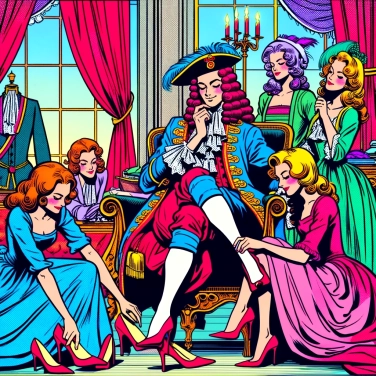Louis XIV wore red heels to display his greatness and wealth. At the time, high heels were a symbol of power and social status, and red was a color associated with royalty.

Louis XIV clearly wanted to assert his authority and status by wearing red heels. At that time, these colorful shoes were far from innocuous: they originally came from a fashion worn by the Persian elite, which European nobles quickly adopted to showcase their social rank. And why red specifically? Because this dye came from a precious and expensive pigment, cochineal, reserved for the wealthy. Louis XIV found it clever to associate this flamboyant color with his feet to clearly symbolize his power, wealth, and absolute authority. Soon, at the court of Versailles, wearing red heels became synonymous with direct influence over the Sun King.
At the court of Versailles, wearing red was not just a matter of fashion. This color directly evoked power, wealth, and a nice nod to nobility. Reserved for people of very high rank, red was made from a very expensive dye obtained from cochineal, a tiny insect that was costly to import. Therefore, walking around with red on oneself was like putting up a sign that clearly stated: "Hey, I am someone important and influential." The choice of scarlet red also expressed the idea of absolute and royal domination: only those who had the monarch's approval could display this shade in public. Louis XIV, by donning his famous red heels, clearly showed the entire court that he held the monopoly on style, but above all, on prestige.
Louis XIV used red heels as a subtle yet effective way to assert his authority over the entire court. By wearing these distinctive heels, he clearly indicated who was in charge, forcing the nobles to follow him if they wanted to remain in his favor. Wearing these shoes was reserved for a small privileged circle: a mark of royal favor that quickly created jealousy and competition. It also allowed Louis XIV to easily spot his allies among his entourage, a practical way to sort friends and rivals at a glance. In short, these famous red heels were primarily a brilliant way for the Sun King to quietly yet firmly establish his political grip.
From the moment Louis XIV adopts the red heels, the entire court rushes to imitate him. Because, honestly, who would say no to the style set by the Sun King himself? Wearing these shoes quickly becomes a way to show one's rank, good taste, and closeness to power. Across Europe, aristocrats think that to be taken seriously, one must absolutely invest in those famous red heels. As a result, this fashion spreads very quickly and has a lasting influence on the clothing display of European elites. By the end of the 17th century, being seen without red heels at Versailles is downright risking an unforgivable fashion faux pas.
Today, the famous red heels of Louis XIV have widely inspired contemporary creators, the most recognizable being surely Christian Louboutin with his iconic red soles, which have become a symbol of elegance and luxury worldwide. We regularly see them on red carpets and at trendy parties, a discreet yet clear sign of a certain class or a nod to royal opulence in the style of the Sun King. Red heels frequently appear through bolder, sometimes even ironic reinterpretations by modern designers seeking to shake up traditions a bit, blending chic homage with a quirky wink. Today, these shoes signify that the visual codes invented by a king centuries ago can still resonate with our desires for power, glam, and distinction.
High heels were originally used by Persian horsemen to secure their feet firmly in the stirrups. It was through this Eastern influence that European fashion, and then Louis XIV himself, adopted high heels as a distinctive sign of aristocracy.
The height and boldness of Louis XIV's heels also corresponded to his relatively modest stature (about 1.63 meters). He wanted to enhance his royal aura by literally giving himself a few extra centimeters of majesty.
The red used at that time to dye heels was extremely rare and expensive. The dye often came from cochineal, an insect native to South America, which made red heels even more exclusive and luxurious.
The famous red heels gave rise to the French expression "être bien dans ses petits souliers," which has since been used ironically to express discomfort or unease. This expression could thus evoke the feeling of discomfort experienced by some individuals trying to adhere to the extravagant style imposed at court.
Under Louis XIV, red heels were primarily reserved for men of the high nobility and the royal court. Nevertheless, some aristocratic ladies also imitated the style, but it was above all a masculine symbol of authority and power.
Louis XIV used appearance as a strategic tool to demonstrate his absolute power, enhance his prestige, and control the nobles. The entire court had to follow his example, thereby contributing to the radiance and unquestioned authority of the Sun King, both politically and culturally.
Although the precise red heels inherited from Louis XIV have vanished with the end of the Ancien Régime, their spirit endures today through various modern reinterpretations in fashion and luxury accessories. Their symbolic reference occasionally surfaces as a sophisticated allusion to that era of absolute elegance.
Red, often associated with wealth, power, and nobility, was an expensive and prestigious color due to its complex manufacturing process. Louis XIV chose red heels as a distinctive mark of royal prestige and superior status over other members of the court.
No, Louis XIV was not the very first sovereign to wear high heels; however, he widely popularized red heels as a specific royal attribute. This aesthetic choice was a true innovation that left a lasting mark on the fashion trends of European aristocracy.
High heels initially appeared in the Middle East, used particularly by Persian horsemen to ensure better stability while riding. This fashion was adopted in Europe starting in the 16th century, before being popularized at court, notably by Louis XIV in the 17th century.

0% of respondents passed this quiz completely!
Question 1/5